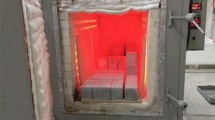Abstract
Experimental test has figured out to investigate behavior of remaining compressive strength concrete prepared using normal and high strength grades. For the same purpose, cube-shaped and cylindrical-shaped specimens of concrete material were casted and consecutively subjected to heating and cooling condition in laboratory-controlled environment. A hold period of three hours was provided to impart heating–cooling phenomenon inside the electrical furnace at four different set of temperatures. The elevated temperatures chosen for the present compressive behavior study are 200, 400, 600 and 800 °C. Strength was also determined at ambient environment for the purpose of comparing the effects of thermal loads on behavior of strength. Significant loss in compression strength has been visualized by plotting the curves for different set of concrete mixes at various temperatures. The compositeness of concrete results as one of the main reason in controlling strength loses inculcated due to elevated temperature. The outcomes of the current experimental work are termed useful while understanding key mechanical characteristics of concrete under the effect of overburdened thermal loads.
Access this chapter
Tax calculation will be finalised at checkout
Purchases are for personal use only
Similar content being viewed by others
References
Saad M, Abo-El-Encini SA, Hanna GB, Kotkatat MF (1996) Effect of temperature on physical and mechanical properties of concrete containing silicafume. J Cem Conc Res 26(5):669–675
Phan LT, Carino NJ (1998) Review of mechanical properties of HSC at elevated temperature. J Mater Civ Eng 10(1):15502
Kodur VKR (1998) Performance of high strength concrete-filled steel columns exposed to fire. J Civ Eng 25(6):975–981
Luo X, Sun W, Chan YN (2000) Residual compressive strength and microstructure of high performance concrete after exposure to high temperature. J Mater Structr/Materiaux et Constr. 33:294–298
Cülfik MS, Özturan T (2002) Effect of elevated temperatures on the residual mechanical properties of high performance mortar. J Cem Conc Res 32:809–816
Li M, Qian C, Sun W (2003) Mechanical properties of high-strength concrete after fire. J Cem Conc Res 35:2192–2198
Phan LT, Carino NJ (2000) Fire performance of high strength concrete: Research needs. In: Proceeding national institute of standards and technology, reprinted from the advance technology in structural engineering, Philadelphia
Phan LT, Carino NJ (2003) Code provisions for high strength concrete strength-temperature relationship at elevated temperatures. J Mater Struct/Materiaux et Constr 36:91–98
Xiao J, Gert K (2004) Study on concrete at high temperature in China-an overview. J. Fire Safety 39:89–103
Kodur VK, Phan L (2007) Critical factors governing the fire performance of high strength concrete systems. J Fire Safety 42:482–488
Behnood A, Ziari H (2007) Effects of silica fume addition and water to cement ratio on the properties of high-strength concrete after exposure to high temperatures. J Cem Conc Compo 30(2):106–112
Alidoust O, Sadrinejad I, Ahmadi MA (2007) A study on cement-based composite containing polypropylene fibers and finely ground glass exposed to elevated temperatures. J World Acad Sci 34
Hachemi S (2014) Evaluating residual mechanical and physical properties of concrete at elevated temperatures. World Acad Sci Eng Technol 86, Publication/9997531
IS: 4031 (Part 1 to 15) (1999) Indian standard methods of physical tests for hydraulic cement. Bureau of Indian Standard, New Delhi
IS: 383 (1970) Indian standards specification for coarse and fine aggregates from natural sources for concrete. Bureau of Indian standards, New Delhi, India
IS: 456 (2000) Indian standard code for design of plain and reinforced concrete structures. Bureau of Indian Standard, New Delhi, India
IS: 10262 (1982) Indian standard recommended guidelines for concrete mix design. Bureau of Indian Standard, New Delhi, India
IS: 516 (1959) Indian standard methods of tests for strength of concrete. Bureau of Indian Standard, New Delhi, India
Author information
Authors and Affiliations
Editor information
Editors and Affiliations
Rights and permissions
Copyright information
© 2020 Springer Nature Singapore Pte Ltd.
About this paper
Cite this paper
Rehman, A., Masood, A., Akhtar, S., Shariq, M. (2020). Effect of Elevated Temperature on the Residual Compressive Strength of Normal and High Strength Concrete. In: Ahmed, S., Abbas, S., Zia, H. (eds) Smart Cities—Opportunities and Challenges. Lecture Notes in Civil Engineering, vol 58. Springer, Singapore. https://doi.org/10.1007/978-981-15-2545-2_17
Download citation
DOI: https://doi.org/10.1007/978-981-15-2545-2_17
Published:
Publisher Name: Springer, Singapore
Print ISBN: 978-981-15-2544-5
Online ISBN: 978-981-15-2545-2
eBook Packages: EngineeringEngineering (R0)




